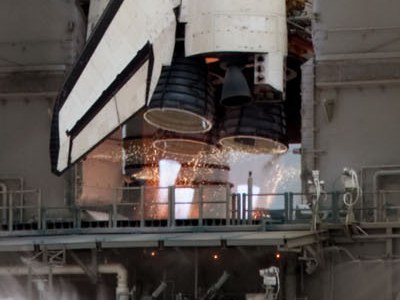Why greens should be pro-spaceby Joseph Mascaro
|
| The folks at Breakthrough even suggest the sad future that “global warming will one day motivate societies to ban things like space tourism.” |
Breakthrough has done some great work on environmental policy—and Branson’s rocket is indeed a bit of a gas-hog—but attacking it as a polluter on par with air travel misrepresents the real environmental impacts of spaceflight and space systems. Had they explored their critique beyond a (two?) cocktail napkin guesstimate, Breakthrough might’ve considered some of the other technologies used for “blasting tourists into space.” So, can spaceflight be green?
First of all, getting into space doesn’t require emitting any carbon in principle. Rocket engines are only carbon emitters if they’re burning hydrocarbons; some engines that powered the US Space Shuttles and Saturn rockets burned hydrogen, not carbon. More specifically, they reacted super-cooled liquid hydrogen with liquid oxygen to release water vapor. The development of these engines is one of the quintessential innovations of the U.S. space program, and it remains the greenest way to fly today, with rocket families like Ariane and Delta. Although plenty of carbon is typically emitted to produce and liquefy the ingredients, such operations run on electricity, so this carbon footprint could be eliminated with a future nuclear power grid of the type Breakthrough advocates.
Second, the carbon dioxide emissions of manned spaceflight are currently nonexistent compared to aircraft and auto emissions. Consider 2012, which saw only five crewed flights (four Soyuz flights, and one Chinese Shenzhou flight); these emitted less than 0.0002% of the carbon dioxide that global air travel did (itself about 2% of all emissions). If Branson succeeds, he’d roughly double the human space flight contribution, meaning it would remain six orders of magnitude less than air travel emissions. Of more important (but still minor) concern may be other climate forcing influences of rocket exhaust. Hydrocarbon rocket fuels, such as the rocket-grade kerosene that powers the Soyuz and SpaceX Falcon 9, also emit large amounts of unburned hydrocarbons in the form of aerosols or soot, which change the heat and light absorption characteristics of the atmosphere. These concerns need greater study, but in any case the conventional carbon dioxide emissions of hydrocarbon rockets will not likely be a major contributor to climate change for many decades.
Next, the article seems to imply that high-powered space enthusiasts are just in it for the joy riding. But, by their own account, they’re simply trying to create a viable private industry, of which tourism is one small piece. These pro-space moneybags are also up to their eyebrows in green tech. Consider that Branson and his competitors are among the most active innovators of green technologies in the world. SpaceX chief Elon Musk is also an electric car kingpin and solar panel installer extraordinaire at the helm of Tesla and Solar City, respectively. Planetary Resources co-founder Peter Diamandis has led the X PRIZE Foundation to support competitions for high-efficiency cars. Clearly, the key players in the industry believe that space exploration and saving the Earth are not contradictory goals.
| Devolving into carbon accounting misses the big picture: innovations from the new space race will help save the Earth. |
On the long view, it is rather surprising that a visionary organization like Breakthrough doesn’t seem to agree. A viable private space industry would be a boon for green technology—producing innovations right in Breakthrough’s wheelhouse. Space systems rely on low-carbon power sources like nuclear and solar; they employ fuel cells and advanced batteries. The viability of the nascent industry is almost wholly dependent on increasing efficiencies and lowering costs—and that means advanced manufacturing systems like 3-D metal printers and reusable rocket stages. Ultimately, having humans living and working in space and in Martian outposts means building closed-loop ecosystems and developing new methods of agriculture and resource sustainability.
All of these technologies will have immediate and dramatic effects at home. Consider efforts to draw down carbon dioxide on Earth, such as those in carbon capture and sequestration. These would benefit immediately from a humans-to-Mars mission like Zubrin’s “Mars Direct,” which uses a well-demonstrated method for extracting carbon dioxide from of the Martian atmosphere to make oxygen for fuel. Even brute-force rocket innovations are going to help: SpaceX has invested untold millions to make rocket stages reusable, particularly high-carbon-footprint components like engines. All reports suggest they are at the cusp of a true, ahem, breakthrough that will cause carbon budgets of regular space launches to plummet.
Perhaps trumping these tangible spinoffs, though, is the collective benefit we get from living in a culture of innovation. The Apollo missions infused our culture with what astrophysicist Neil deGrasse Tyson calls the “dreams of tomorrow.” Kids grew up wanting to be astronauts and then switched gears to be cancer biologists or child developmental psychologists or climatologists. Breakthrough Institute founders Michael Schellenberger and Ted Nordhaus recognized the power of this culture of innovation when they named their energy independence plan “Apollo II.”
Today, Branson, Musk and others are burning a tad more than their fair share of carbon trying to build a new space industry. But devolving into carbon accounting misses the big picture: innovations from the new space race will help save the Earth.
